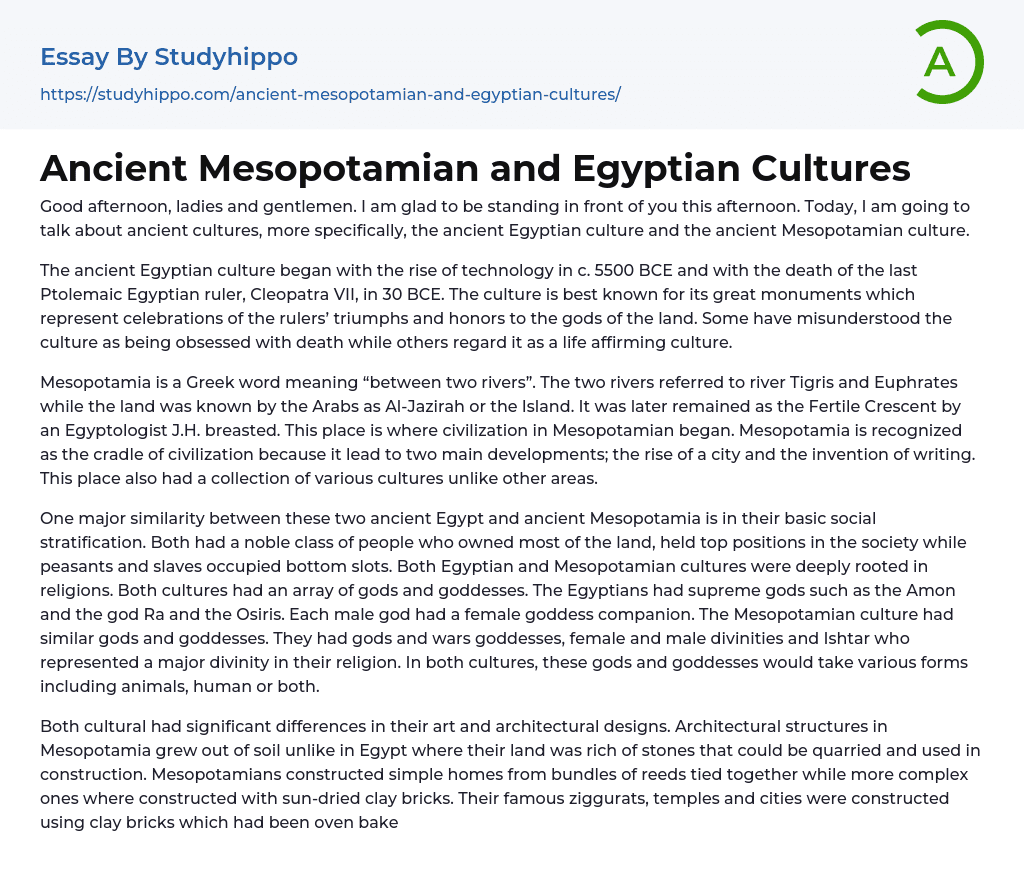Today, I am delighted to discuss two ancient cultures: the ancient Egyptian culture and the ancient Mesopotamian culture. The ancient Egyptian culture lasted from around 5500 BCE until the reign of Cleopatra VII ended in 30 BCE, signifying the conclusion of Ptolemaic Egypt.
The culture is renowned for its impressive monuments representing the rulers' triumphs and their tributes to the gods of the land. While some perceive this civilization as being preoccupied with death, others interpret it as a commemoration of life. Mesopotamia, derived from Greece meaning "between two rivers," pertains to the Tigris and Euphrates Rivers. The Arabs called this region Al-Jazirah or the Island. Subsequently, Egyptologist J.H. labeled it as the Fertile Crescent.
Mesopotamia, the cradle of human civilization, is renowned for its crucial contribution to urban development and the invention of written language. This region served as a cult
...ural hub, distinguishing it from neighboring areas.
Both Egypt and Mesopotamia, ancient civilizations, had similarities in their social structure. They both had a noble class that owned most of the land and held respected positions in society, while lower levels were filled with peasants and slaves. Religion played a vital role in both cultures as they worshipped different pantheons of gods and goddesses. In Egypt, this included supreme deities such as Amon, Ra, and Osiris.
In both the Egyptian and Mesopotamian cultures, male gods were accompanied by female goddesses. Both cultures had gods linked to war and goddesses representing important deities, like Ishtar in Mesopotamia. These divine beings could take on different forms, whether as animals or humans. However, the art and architectural designs of the two cultures exhibited notable differences.
Architectural structures in Mesopotamia were built using soil,
as opposed to Egypt where the land was rich in stones for construction. In Mesopotamia, simple homes were made by binding bundles of reeds together, while more complex structures were constructed using sun-dried clay bricks. Their famous ziggurats, temples, and cities were also built with oven-baked and painted clay bricks. Both cultures developed along rivers to adapt to the harsh desert climate and shared strong beliefs in their leaders, complex religious beliefs, well-written languages, and impressive architectural designs. However, the differences between these two cultures stemmed from variations in geography, prior beliefs, and exposure to external influences and invasions. These two cultures have left lasting influences on the world in various ways.
The modern construction methods, including the use of steel, power glue, and concrete, have been influenced by the architectural designs of ancient Egypt. Similarly, the 24-hour system, 12-month year, and four-week month that astronomers in ancient Egypt originally devised are still widely used today. Likewise, circumcision, which initially served hygienic purposes in ancient Egypt, is now practiced in various regions worldwide. Agricultural practices also incorporate irrigation techniques similar to those employed in ancient Mesopotamia. Additionally, there has been significant widespread adoption of geometry and other customs from ancient Egypt.
A Comparison between Ancient Mesopotamia and Ancient Egypt
Geography:
- Ancient Mesopotamia was located between the rivers Tigris and Euphrates.
- Ancient Egypt was situated alongside the river Nile.
Architectural designs:
- Construction in Ancient Mesopotamia involved using soil and reeds.
- Construction in Ancient Egypt utilized stones.
Further Comparisons between Ancient Mesopotamia and Ancient Egypt
Agriculture:
- Artificial irrigation was practiced along the rivers Tigris and Euphrates in ancient Mesopotamia.
- Artifical irrigation was also carried out along the river Nile in ancient Egypt.
Social hierarchy:
- In ancient Mesopotamia, there were specialized patriarchal slaves who engaged in various tasks such as pottery, leather making, brick-making, stone cutting, textile production, and woodwork.
Both societies had a noble class.
Religion:
- American Culture essays
- Car Culture essays
- Cultural Differences essays
- Culture Shock essays
- Different Cultures essays
- Indian Culture essays
- Mexican Culture essays
- Mormon essays
- Pop Culture essays
- Popular Culture essays
- Ageism essays
- Cultural Diversity essays
- Discrimination essays
- Diversity essays
- Gender Discrimination essays
- Multiculturalism essays
- Oppression essays
- Peer Pressure essays
- Racial Profiling essays
- Sexism essays


Unfortunately copying the content is not possible
Tell us your email address and we’ll send this sample there.
By continuing, you agree to our Terms and Conditions.


